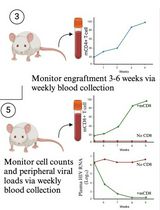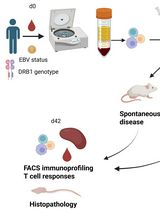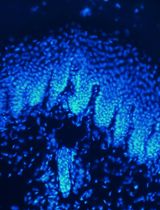- EN - English
- CN - 中文
Simultaneous Intranasal/Intravascular Antibody Labeling of CD4+ T Cells in Mouse Lungs
小鼠肺CD4+ T细胞的鼻内/血管内抗体同时标记
(*contributed equally to this work) 发布: 2017年01月05日第7卷第1期 DOI: 10.21769/BioProtoc.2099 浏览次数: 12556
评审: Ivan ZanoniShanie Saghafian-HedengrenAnonymous reviewer(s)
Abstract
CD4+ T cell responses have been shown to be protective in many respiratory virus infections. In the respiratory tract, CD4+ T cells include cells in the airway and parenchyma and cells adhering to the pulmonary vasculature. Here we discuss in detail the methods that are useful for characterizing CD4+ T cells in different anatomic locations in mouse lungs.
Keywords: Memory CD4+ T cell (记忆CD4+ T细胞)Background
To distinguish memory T cells in the circulation and tissues, a method for intravascular staining of T cells has been developed (Anderson et al., 2012). This method has been widely used to define memory T cells in many organs and tissues, including lungs, spleens and intestines. However, memory T cells in the respiratory tract are located in three unique anatomic locations, i.e., airway, parenchyma and pulmonary vasculature. Intravascular staining cannot distinguish cells in the airway and parenchyma, since they are both isolated from the circulation and intravascularly-administered antibodies will not stain these two populations. We designed a simultaneous intranasal/intravascular antibody labeling assay that can label and distinguish cells in all three locations using minimal amount of antibodies.
Materials and Reagents
- 1.5 ml microtubes (Thermo Fisher Scientific, Thermo ScientificTM, catalog number: 69715 )
- 1 ml insulin syringe fitted with 28 G x ½ needle (BD, catalog number: 329420 )
- Precision glide needles (20 G x 1) (BD, catalog number: 305175 )
- 5 ml polystyrene round bottom tubes (Corning, Falcon®, catalog number: 352054 )
- Precision glide needles (25 G x 5/8) (BD, catalog number: 305122 )
- 200 μl tips (Thermo Fisher Scientific, InvitrogenTM, catalog number: AM12655 )
- 15 ml screw cap conical tubes (SARSTEDT, catalog number: 62.554.002 )
- 10 ml syringes (BD, catalog number: 309604 )
- 12 well cell culture plates (Corning, Costar®, catalog number: 3513 )
- 3 ml syringes (BD, catalog number: 309657 )
- 50 ml screw cap conical tubes (SARSTEDT, catalog number: 62.547.004 )
- Cell strainers (70 µm nylon) (Corning, Falcon®, catalog number: 352350 )
- 60 x 15 mm tissue culture dish (Corning, Costar®, catalog number: 353802 )
- 10 ml stripettes (Corning, Costar®, catalog number: 3548 )
- Gauze sponges (4 x 4 inch) (Pro Advantage by NDC, catalog number: P157118 )
- 0.2 μm filter (EMD Millipore, catalog numbers: SCGPU11RE and SLGP033RS )
- 2.5 ml graduate transfer pipettes (RPI, catalog number: 147501-1S )
- Absorbent pads (COVIDIEN, catalog number: 949 )
- Mouse
- CD45-brilliant violet 510 (BV510) (Clone: 30-F11) (BioLegend, catalog number: 103138 )
- 1x Dulbecco’s phosphate buffered saline (DPBS) (Thermo Fisher Scientific, GibcoTM, catalog number: 14190-144 )
- CD90.2-APC-eFluor 780 (Clone: 53-2.1) (Affymetrix, eBioscience, catalog number: 47-0902 )
- Isoflurane (USP inhalation vapour, liquid) (Drugs, catalog number: 57319-559-06 )
- Ethanol (Sigma-Aldrich, catalog number: 459836 )
- Trypan blue solution (Thermo Fisher Scientific, GibcoTM, catalog number: 15250061 )
- CD16/32-PerCP/Cy5.5 (Clone: 93) (BioLegend, catalog number: 101324 )
- CD4-FITC (Clone: RM4-5) (BioLegend, catalog number: 100510 )
- 2,2,2-tribromoethanol (Sigma-Aldrich, catalog number: T48402 )
- 2-methyl-2-butanol (Sigma-Aldrich, catalog number: 152463 )
- Nano-pure water (Thermo Fisher Scientific, InvitrogenTM, catalog number: 10977015 )
- RPMI medium 1640 (Thermo Fisher Scientific, GibcoTM, catalog number: 11875093 )
- HEPES (1 M) (Thermo Fisher Scientific, GibcoTM, catalog number: 15630080 )
- L-glutamine (200 mM) 100x (Thermo Fisher Scientific, GibcoTM, catalog number: 25030081 )
- Fetal bovine serum (FBS) (Atlanta Biologicals, catalog number: S11150 )
- MEM non-essential amino acids solution 100x (Thermo Fisher Scientific, GibcoTM, catalog number: 11140050 )
- Sodium pyruvate 100x (Thermo Fisher Scientific, GibcoTM, catalog number: 11360070 )
- Penicillin/streptomycin 100x (Thermo Fisher Scientific, GibcoTM, catalog number: 15140122 )
- 2-mercaptoethanol (Sigma-Aldrich, catalog number: M6250 )
- Collagenase D (Roche Diagnostics, catalog number: 11088882001 )
- DNase I (Roche Diagnostics, catalog number: 10104159001 )
- Hank’s balanced salt solution (HBSS) (Thermo Fisher Scientific, GibcoTM, catalog number: 14025 )
- Sodium azide, NaN3 (AMRESCO, catalog number: 0639 )
- Potassium bicarbonate, KHCO3 (Sigma-Aldrich, catalog number: 237205 )
- Ammonium chloride, NH4Cl (Sigma-Aldrich, catalog number: A9434 )
- EDTA-Na2 (Sigma-Aldrich, catalog number: E9884 )
- BD Cytofix fixation solution (BD, catalog number: 554655 )
- Avertin (see Recipes)
- Complete RPMI 1640 medium (see Recipes)
- Digestion buffer (see Recipes)
- FACS buffer (see Recipes)
- ACK lysis buffer (see Recipes)
Equipment
- Desiccator (SP Scienceware - Bel-Art Products - H-B Instrument, model: Space Saver Vacuum Desiccators )
- Fume hood (LABSCAPE)
- Pipetman P10 (Eppendorf, model: Research plus )
- Pipetman P200 (Eppendorf, model: Research plus )
- Pipetman P1000 (Eppendorf, model: Research plus )
- Pipet aid (Eppendorf, model: Eppendorf Easypet 3 )
- Heat lamp (Whitehead Industrial, catalog number: 30715 )
- Mouse restrainer (Braintree Scientific, catalog number: TV-150 STD )
- Spray bottle with 70% ethanol (SKS Science Products, catalog number: 0185-11 )
- Surgical scissors (Sklar Surgical Instrument, catalog number: 47-1246 )
- Tweezers (Sklar Surgical Instrument, catalog number: 66-7644 )
- Polystyrene foam (Regular polystyrene box top)
- Rocker (Labnet, catalog number: S0500 )
- Refrigerated tabletop centrifuge (Beckman Coulter, model: Allegra 6R )
- Hemocytometer (Thermo Fisher Scientific, catalog number: 99503 )
- Flow cytometer (BD, model: FACSVerse)
Software
- Flowjo software (Version 10.0.7)
Procedure
文章信息
版权信息
© 2017 The Authors; exclusive licensee Bio-protocol LLC.
如何引用
Wang, Y., Sun, J., Channappanavar, R., Zhao, J., Perlman, S. and Zhao, J. (2017). Simultaneous Intranasal/Intravascular Antibody Labeling of CD4+ T Cells in Mouse Lungs. Bio-protocol 7(1): e2099. DOI: 10.21769/BioProtoc.2099.
分类
免疫学 > 动物模型 > 小鼠
细胞生物学 > 细胞染色 > 蛋白质
您对这篇实验方法有问题吗?
在此处发布您的问题,我们将邀请本文作者来回答。同时,我们会将您的问题发布到Bio-protocol Exchange,以便寻求社区成员的帮助。
Share
Bluesky
X
Copy link













